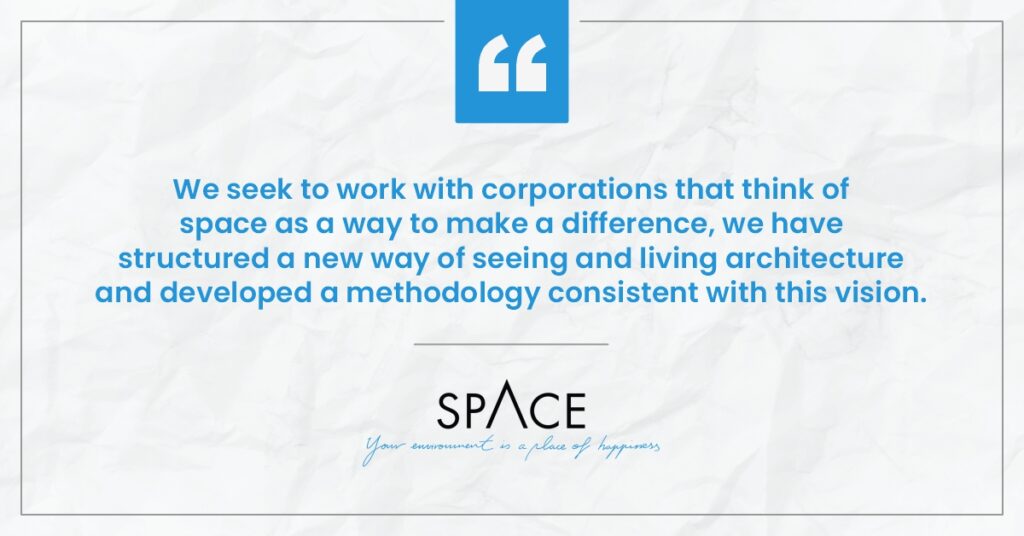Trending
April 10, 2025
February 15, 2025
February 2, 2025
The Architect Juan Carlos Baumgartner is a founding partner of the international architectural firm Space. Since his initial days as a professional architect, he has been clear that architecture has enormous power to transform society. Although he witnessed that architecture and design firms have not created methodologies and research to understand how to utilize the power.
Juan Carlos and his team started working with a lot of psychologists and anthropologists in order to focus a lot on behavior and its relationship with the environment. He explains, “The evolution of our philosophy has been closely linked to technological advances that allow us today to understand much more how the mind works and the relationship of our cognitive processes with built environments.”

Originally established in Chicago, today Space has offices in Mexico City, Guadalajara, and Monterrey, and associated offices in LATAM, Spain, Brazil, and Holland, among other countries. Juan Carlos aimed to create spaces with sustainable technologies that improve the surroundings, according to the essence, values, characteristics, and needs of each project.
He reflects that: “Architecture can be a tool for improving society”. Thus, to fully understand the organization, he has developed his own methodologies for empathetically understanding the company´s core, helping to align the strategies, and offering architectural solutions that improve the productivity of the organization and the efficiency, inspiration, and happiness of the individual. His experience includes corporate architectural projects, interior and exterior, hotels, commercial architecture, points of sale, shopping centers, residential architecture, and a particular interest in creating better spaces for education. Recently he was included on the Forbes 100 most Creative Mexicans in the world.
Juan Carlos has honed expertise in cognitive neuroscience applied to architectural design, being one of the few specialists in this field globally. The uniqueness of their offerings coupled with his expertise compelled us to know more about Space and what it was doing to improve the architectural industry. We recently interviewed Juan Carlos and had an insightful chat, here are the excerpts.
1.Could you walk us through the initial journey of Space?
I opened space 22 years ago intending to change people’s lives through the use of design. Initially, the focus was on corporate spaces and today we are working in hotels, commercial spaces, and education.
2.What challenges did you encounter in your journey to become one of the innovative companies in the industry?
The decision to do an interdisciplinary practice requires creating methodologies for new processes that include different experts. Recently the focus has been much on neuroscience and for this, we have not had to prepare and study neuroscience because it is the only way to become a bridge between these two previously unrelated disciplines.
3.What makes Space’s services innovative as compared to the other providers in the industry?
We design all our projects with what some known as neuroarchitecture. Within our teams, we have from scientists to psychologists who seek in all projects how to generate spaces that generate well-being. An area of the company is focused on research, also having a research area led by an environmental psychologist is not a common practice in the industry.our processes and methodologies are hybrid and mix knowledge of philosophy, branding, architecture, and knowledge sciences. We developed an algorithm a few years ago that helps us interview thousands of people in 15 minutes and with which we can measure many determining factors to improve the designs we work on.
4.How will you describe the team at Space?
Our team is made up of very talented people who, in most cases, have been collaborating with us for years. Our philosophy related to innovation is based on the idea of sharing knowledge among diverse people. That is why the company has expertise in topics as diverse as philosophy or branding, all with an obsession to serve the client and change the lives of those who use our spaces.
5.According to you, what qualities must an innovative company have?
6.What are the ground-breaking changes that you expect to see in the industry?
Today most architecture firms talk about putting human beings at the center of what they do and doing human-centric design, but the problem is that most of these organizations do not make an effort to understand what it means to be human today. The evolution that I see in the industry will be to see more and more architecture companies developing deeper knowledge about the human being and his behavior in most cases through the use of technology and behavioral sciences. I think the architecture industry has done things very similarly for too long, and it’s time for a change.
7.What can we expect from the Space team in the coming year?
We are initiating research in conjunction with a neuroscience laboratory in Canada to try to find the relationship between built environments and behaviors in children with ADHD.
Likewise, we developed a theory called “design for happiness” that explains how to promote positive emotions through architecture.
